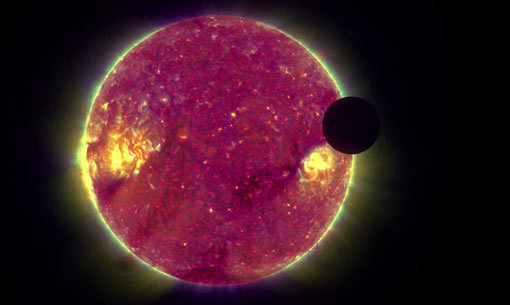You are hereBlogs / WcP.Scientific.Mind's blog / A sweeping prominence, a huge cloud of relatively cool dense plasma is seen suspended in the Sun's hot, thin corona
A sweeping prominence, a huge cloud of relatively cool dense plasma is seen suspended in the Sun's hot, thin corona

(quote)
A sweeping prominence, a huge cloud of relatively cool dense plasma is seen suspended in the Sun's hot, thin corona. At times, prominences can erupt, escaping the Sun's atmosphere. Emission in this spectral line shows the upper chromosphere at a temperature of about 60,000 degrees K (over 100,000 degrees F). Every feature in the image traces magnetic field structure. The hottest areas appear almost white, while the darker red areas indicate cooler temperatures.
The Sun is now in the quietest phase of its 11-year activity cycle, the solar minimum - in fact, it has been unusually quiet this year - with over 200 days so far with no observed sunspots. The solar wind has also dropped to its lowest levels in 50 years. Scientists are unsure of the significance of this unusual calm, but are continually monitoring our closest star with an array of telescopes and satellites. Seen here are some recent images of the Sun in more active times.

A transit of the Moon across the face of the Sun on February 25, 2007 - but not seen from Earth. This sight was visible only from the STEREO-B spacecraft in its orbit about the sun, trailing behind the Earth. NASA's STEREO mission consists of two spacecraft launched in October, 2006 to study solar storms. STEREO-B is currently about 1 million miles from the Earth, 4.4 times farther away from the Moon than we are on Earth. As the result, the Moon appears 4.4 times smaller than what we are used to. (NASA/STEREO)

Detailed closeup of magnetic structures on the Sun's surface, seen in the H-alpha wavelength on August 22, 2003. (Swedish 1-m Solar Telescope (SST) operated by the Royal Swedish Academy of Sciences, Oddbjorn Engvold, Jun Elin Wiik, Luc Rouppe van der Voort)

The total solar eclipse of February 16, 1980 was photographed from Palem, India, by a research team from the High Altitude Observatory of the National Center for Atmospheric Research. The photograph of the solar corona was taken with a camera system developed by Gordon A. Newkirk, Jr. This specialized instrument photographs the corona in red light, 6400 A -- through a radially graded filter that suppresses the bright inner corona in order to show the much fainter streamers of the outer corona in the same photograph. (Rhodes College, Memphis, Tennessee / High Altitude Observatory (HAO), University Corporation for Atmospheric Research (UCAR))

The planet Venus is seen by NASA's TRACE satellite, at the start of its transit across the sun on June 8, 2004. (NASA/TRACE)

The Sun, observed on May 22, 2008. With the Sun persisting in a near-minimal state of activity, only a few small regions of some activity are seen on the disk. The cell-like appearance is formed by the multitude of small clusters of magnetic flux that are collected in the downflow regions of the supergranular network of convective motions. (NASA/TRACE) #
(unquote)
Photos courtesy of SOHO/EIT consortium, Royal Swedish Academy of Sciences, University Corporation for Atmospheric Research, and NASA
Original Source: Boston Globe
Related Articles: Sun Hits a 50-Year Low and Weaker Solar Wind Won't Slow Global Warming, May Threaten Astronauts



















All of these pictures are extra efficient and it can only happen in NASA from Academy of Sciences. I am a researcher and I salute to all the researcher who did the flawless job to find cool dense plasma.